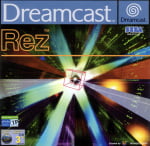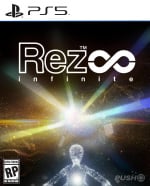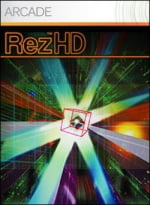
It's almost remarkable to think that Rez is now over 20 years old – especially when you consider it has recently been used to showcase the PSVR2's much-hyped eye-tracking technology. If you look at games that launched around the same time as Rez in 2001 – Luigi's Mansion, Pikmin, Devil May Cry – then it's striking just how utterly timeless its visuals are. Rez felt like a glimpse of the future back in the Dreamcast's dying days, and given that it is still capable of captivating players with its presentation in 2023, it's a future we clearly haven't reached yet.
The merging of sound and light and the meaning behind it all perfectly synched in my head. I’d had a number of thoughts brewing for years. Something to do with the marriage of game and music, creating music as you shoot down enemies
Rez is the brainchild of former Sega staffer Tetsuya Mizuguchi, who joined the company in 1990 and would work on software for Sega's hydraulic AS-1 motion simulator before producing the arcade smash hit Sega Rally Championship. It was during a research trip for AM3's famous racing title that the first seeds that would lead to Rez's development were sown. "I travelled a lot while working on Sega Rally," he says. "On one of the trips, I was taken to a street parade in Zurich, Switzerland. 300,000 people had gathered in the city centre for a concert. It blew me away. I think it appealed to the art student in me: the merging of sound and light and the meaning behind it all perfectly synched in my head. I’d had a number of thoughts brewing for years. Something to do with the marriage of game and music, creating music as you shoot down enemies. When the home console technology arrived at a point where I felt able to bring the idea to life, I knew it was time. I wanted to make a game that could put the player into a trance-like state." Mizuguchi's quest to realise 'synesthesia' in video games had begun.
Mizuguchi renamed Sega R&D #9 to United Game Artists in 2000, and it would be this wholly-owned Sega subsidiary that would craft what would eventually become Rez. While the team was mostly comprised of Japanese developers, American Jake Kazdal was also involved. Today, Kazdal runs the Kyoto-based 17-Bit (Skulls of the Shogun, Galak-Z: The Dimensional, Song in the Smoke), but back in the late '90s, he was still looking for his big break in the games industry, having previously worked at Enix and Irem as a game counsellor and play-tester respectively.
"I was introduced to Mizuguchi over email by our mutual friend Kenneth Ibrahim, who had worked previously with Mizuguchi-san at Sega’s AM3 studio," recalls Kazdal. "If you played Sega Rally, you’ll know his voice because he is the guy who says: 'LONG MEDIUM LEFT.' It was just a few weeks before E3 1998, and I hustled together a demo tape of my animation and art work. Mizuguchi was kind enough to make time to meet me during the show, where we secured a meeting room at the Sega booth, and I showed him my demo reel. We had dinner and quite a few drinks later in the week. Then we started talking a bit about his vision for what would become Rez, at which point I started shamelessly begging for a job."
Mizuguchi's experience in Zurich would become a core part of Rez's game design; he wanted to fully realise the connection between visuals and audio in a way that hadn't previously been attempted in an action game. "From time to time, I would recall the music from the game Xevious, which I had played as a child," he says. "I figured, if that music kept coming into my head all these years later, then it must have a special power. Jun Kobayashi was a VJ friend of mine. He was an artist, really. I met him, and I discussed my idea for Rez. We talked about Kandinsky, the artist who would paint while inspired by music. And this is what Jun and I wanted to do with Rez. We experimented and experimented, using all kinds of different art styles. We went to many clubs, where we would watch people’s reactions to the music."
For such a unique project, Mizuguchi would need designers who understood his aims and objectives – so he gave Kazdal a call. "Miz invited me out to Tokyo to tour the new game studio he was building, which became UGA, right in the heart of Shibuya," Kazdal says. "There, he took me to a trance party for the weekend in the forest, many hours' drive outside of Tokyo. He ended up offering me the job, which changed my life forever."
We experimented and experimented, using all kinds of different art styles. We went to many clubs, where we would watch people’s reactions to the music
Rez wasn't to be the sole focus of United Game Artists at this point; while it was in production, the studio was also working on fellow Dreamcast music title Space Channel 5. The responsibility of nurturing two games at the same time placed unique demands not just on the company but its leader as well – although Mizuguchi feels this was a primarily favourable arrangement. "At Shibuya, I expanded the team to seventy-odd people. It was a tough process. We were making Space Channel 5 and Rez simultaneously. But that also helped me to not go mad; I could switch between games, one of which was pure entertainment, and the other which was something quite deep and elemental. I worked so hard. I slept at my desk. I never went home. It was gruelling but fun. I was so caught up in my games that I didn’t have much time or space to think about the larger Dreamcast project. I just knew that if I could make something special, then it would help the Dreamcast."
For Kazdal, joining United Game Artists was somewhat bittersweet; while he was given a chance to experience Japan, a country he had always had a fondness for (indeed, it is now his home), he initially felt somewhat out of his depth. "I was the only non-Japanese person on the Rez team. The first few months were tough, no doubt. People were so sweet and patient with me, but they were busy, and I spent a lot of time just writing down words that kept popping up at meetings and tracking people down later to break them down for me. Within a year or so, though, I was pretty chatty and only really screwed up by not learning to read and missing out on all the inter-team text chat. Luckily I used my eyes and hands to communicate more than my words for my job."
While video games based around music had existed before, Mizuguchi and his team were doing a lot of pathfinding with Rez, as it would combine graphics and music in a way that had not previously been attempted. This required a considerable amount of work. "We had to do a lot of research because there weren’t really any games like this at the time, or at least, not enough to consider it a genre," says Mizuguchi. "I took my team to Taiko drumming festivals, and we also watched hours and hours of recordings of street musicians. It wasn’t just a case of listening to the music. We also took notice of the shapes and colours and how we felt as the performance progressed. These were all things we wanted to translate into our game. The basic idea was that shooting would produce sounds, which could then synch with the music. Quantization was key to ensure that the sounds players made fell in step with the music. This would mean that any player could play the game 'in time' as it were; the rhythms of play would always be synched, and play would feel good. When we first made this work, it felt like magic."
We added the new elements, like the DJ playing, changing the backing track, which gave it movement and changes of mood. When we added in that element, whereby shooting the cubes changed the backtrack, it all started to fall into place. It felt like we finally had the mechanics working
Inspiration would arise from all kinds of places during development. "One of my biggest influences was almost accidental," says Kazdal, who would design, model and animate a selection of enemies for Worlds 1 and 2. "I had been out clubbing in Tokyo one weekend and got entranced with the WinAmp sound visualizations a VJ was using. I videotaped a bunch and showed it to Mizuguchi the next week while we were deep in visual development early on in Rez, and that really drove the future of all the style for the rest of the project."
Elsewhere, a street party in Kenya would provide a different sort of inspiration. "Nobuhiko ‘Ebizo’ Tanuma, my creative partner who was the sound director on the game, travelled to Kenya and shot a video there, on the street," explains Mizuguchi. "People were eating dinner outside, then suddenly one guy starts up a rhythm. Then everyone around them begins to join in; the women begin to sing. I watched the video many, many times, especially the way the sound built up. It was a big step in the creative development of the game. How can we groove, with any action becoming music? How do these actions become a part of the soundscape? How do we make sure they are in time? We played around with this stuff, but it still didn’t feel good. Then, finally, we added the new elements, like the DJ playing, changing the backing track, which gave it movement and changes of mood. When we added in that element, whereby shooting the cubes changed the backtrack, it all started to fall into place. It felt like we finally had the mechanics working."
During the development of both Space Channel 5 and Rez, Sega announced that it was exiting the video game hardware business to become a third-party publisher. As a result, Rez would become a transitional product for the company; it was one of the last games for Dreamcast, Sega's last console, and one of the first Sega games to appear on the Sony PlayStation 2. Mizuguchi was keenly aware that both of United Game Artists' titles were weighed down with a degree of expectation, and he decided to make as solid an impression as possible.
"In 2001, before the game’s release, I had the chance to show Rez at the PlayStation Party in Shibuya, Tokyo," says Mizuguchi. "I remember it so clearly. I’d decided to show the game without words. I just wanted to play the game in front of people, through a huge sound system, without any comments, then leave the stage. The day before, I dyed my hair silver. I didn’t know the Sony people at all. It was like playing an away game. I was so nervous. I took to the stage in this huge club. After I played, I went backstage, and I was so nervous. I didn’t know how people had reacted because it was so dark. Suddenly I heard my name being said from the stage. It was the chairman of Sony Music, Shigeo Maruyama, calling me back. He was the godfather of Sony Music. Everyone respected him. And he said, on stage: 'I think this game could change the history of music.' After the party, I thanked him, and he told me: 'That wasn’t marketing talk. That’s how I really feel.' Up until that party, the Sega marketing people didn’t seem very excited about Rez. But that night, at the party, there were Sega people in the audience. And they saw me play. And then they saw Maru-san come on stage and compliment me. The next time I went to the Haneda office, it was very different. Sega was like: 'We better start supporting this game.'"
It was the chairman of Sony Music, Shigeo Maruyama. He was the godfather of Sony Music. And he said, on stage: 'I think this game could change the history of music.'
Rez launched to enthusiastic reviews which praised the fusion of music and action and compared it very favourably to the likes of Panzer Dragoon and Space Harrier, two of Sega's most famous games. However, the commercial response was much less impressive. "The reaction generally to both Space Channel 5 and Rez was very positive, but sales were not," admits Kazdal. "I remember the stress taking its toll on Mizuguchi, and we were disappointed neither game became a runaway hit."
In September 2003, Sega would internally restructure its staff, which included the dismantling of United Game Artists, with its members being reassigned to Sonic Team. Mizuguchi didn't stick around to see the results; a month later, he announced his departure from the company he had worked at for 13 years. He would establish Q Entertainment and continue his experiments in the realm of synesthesia; the PSP title Lumines was one of the studio's first releases. In 2014, he departed Q Entertainment to establish Enhance, Inc, creator of Tetris Effect and updated versions of Lumines and Rez.
Despite failing to meet expectations at the time of release, Rez has gone on to be recognised as one of the most important video games of all time and continues to generate revenue and acquire new fans via Rez Infinite, an updated version of the game which was first released in 2016. "In hindsight, I don't think anyone could have foreseen just how popular these games would continue to be," says Kazdal of Rez and Space Channel 5's enduring popularity.
People to this day tear up when I tell them I worked on Rez. I couldn't be prouder of what we achieved.
More than twenty years have passed since Mizuguchi set out on his quest to unify the worlds of music and video games in an entirely new way, and he shows no signs of abandoning his quest. In a recent podcast with Simon Parkin, Mizuguchi stated that he was prepared to commit the rest of his working life to exploring synesthesia in interactive entertainment. The continuing evolution of Rez is a testament to that; as previously mentioned, the game now supports groundbreaking eye-tracking tech to facilitate its gameplay on PSVR2 – and it's clear that the game itself will keep on providing entertainment for decades to come.
For Kazdal, it remains a special part of his life. "I loved the fact that we were this crazy, experimental team based in the heart of the youth scene in Shibuya. I didn’t know how lucky I was when it first happened. Mizuguchi was the perfect guy to lead the team, and we went deep, trying to break new ground and establish new genres, and I think we wildly succeeded on that front. As a CEO now, years later, I realize how much sales have to drive design decisions, but at the time, we had a long leash and big dreams. Silky smooth anti-aliased Rez on Dreamcast still gives me goose-bumps. I think the long hours of development with the kit booting up, the boot up sounds; every time I hear them, I still just get this warm fuzzy feeling. Working with people so talented and driven on a bold, daring adventure into new uncharted territory deep in the heart of Tokyo, it just shaped me as a human, and I'll never forget any of that. People to this day tear up when I tell them I worked on Rez. I couldn't be prouder of what we achieved."
This piece is based on an interview previously published in Read-Only Memory's Sega Dreamcast: The Collected Works and has been used here with very kind permission.










